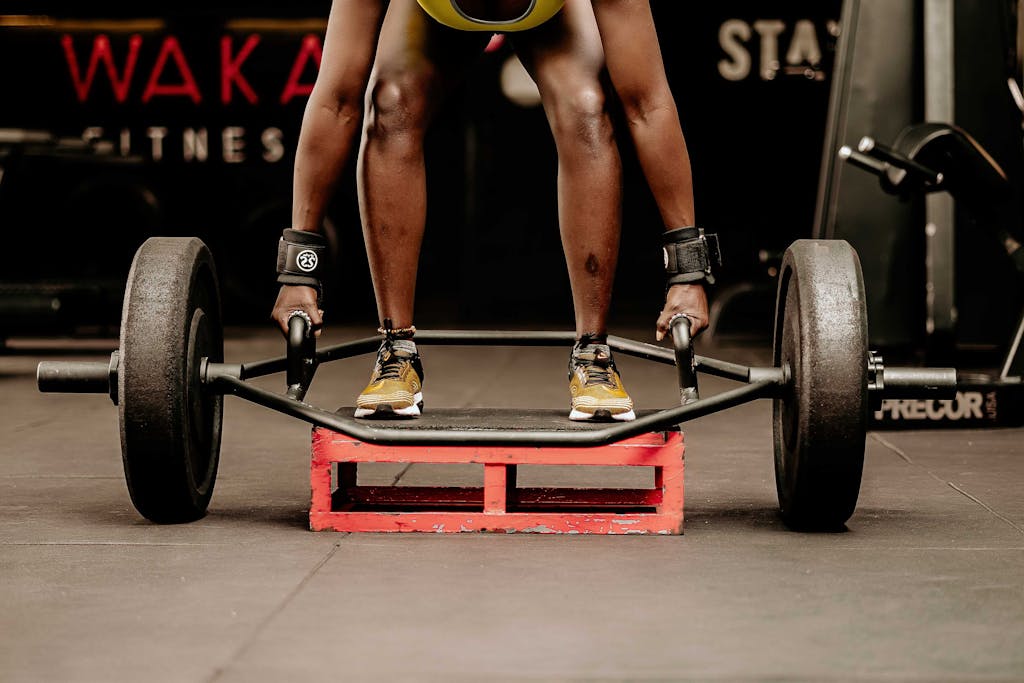FREE SHIPPING OVER $50
How to Do the Perfect Hex Bar Deadlift: Variations & Alternatives
The hex bar, also known as the trap bar, is a unique piece of fitness equipment that’s taking the fitness world by storm. Its hexagonal design and dual handles offer a fresh take on traditional weightlifting, making it a must-have for any serious fitness enthusiast. But what sets the hex bar apart, and how can you use it to perform the perfect deadlift? Let’s dive in.
Video Guide:
The Hex Bar: A Game Changer in Weightlifting
The hex bar is a versatile piece of equipment that can transform your weightlifting routine. Unlike a standard barbell, the hex bar allows you to stand inside it, aligning the weight with your body’s center of gravity. This alignment reduces strain on your lower back and promotes a more natural lifting posture, making the hex bar an excellent choice for deadlifts.
Benefits of Hex Bar Deadlift
The hex bar deadlift is a versatile exercise with numerous benefits:
- Reduced Stress on the Spine: The design of the hex bar allows for a more upright torso position, which can reduce the shear stress on the spine compared to traditional deadlifts.
- Improved Posture: Regularly performing hex bar deadlifts can strengthen your back and core muscles, which can help improve posture.
- Versatility: The hex bar can be used for a variety of exercises, making it a versatile addition to any workout routine.
- Increased Power: Studies have shown that athletes can generate more power during a hex bar deadlift compared to a traditional barbell deadlift.
- Safety: The design of the hex bar makes it easier to drop if you lose your grip or balance, making it a safer option for heavy lifts.
Mastering the Hex Bar Deadlift

The hex bar deadlift is a compound exercise that targets multiple muscle groups, including your glutes, hamstrings, quads, and lower back. Here’s how to do it:
- Position Yourself: Stand in the center of the hex bar, feet hip-width apart.
- Grip the Handles: Bend at your hips and knees to lower yourself down to the handles. Ensure your back is straight and your chest is up.
- Lift the Weight: Push through your heels to lift the bar off the ground. Keep your core engaged and your back straight as you rise to a standing position.
- Lower the Weight: Reverse the movement to lower the bar back to the ground, maintaining control throughout the movement.
Remember, the key to a successful hex bar deadlift is form, not weight. Start with a lighter weight to master the technique before gradually increasing the weight.
Hex Bar Weight: Finding the Right Balance
The weight of a hex bar, also known as a trap bar, is not standardized like a traditional Olympic barbell, which typically weighs 45 pounds. Instead, the weight of a hex bar can vary based on its make and model. Most hex bars weigh between 40 and 70 pounds, with some well-known brands falling somewhere between 40 and 70 lbs or 18-32kg. However, some hex bars can weigh as little as 30 pounds or as much as 75 pounds.
The weight of your hex bar can significantly impact your workout. A heavier hex bar, for instance, can help build strength and muscle mass. This is because lifting heavier weights, with fewer repetitions, is a common strategy for muscle growth and strength gains. On the other hand, a lighter hex bar can be used for endurance training or rehabilitation. Lifting lighter weights for more repetitions can help improve muscular endurance and is often recommended for those recovering from an injury.
The right weight for you depends on several factors. Your fitness goals are a major consideration. If you’re aiming to build muscle and strength, a heavier hex bar may be more suitable. If you’re focusing on endurance or are in the process of rehabilitating an injury, a lighter hex bar may be more appropriate.
Your experience level and physical condition also play a role. If you’re new to weightlifting, starting with a lighter hex bar can help you learn proper form and technique, reducing the risk of injury. As you gain experience and strength, you can gradually increase the weight.
Hex Bar vs Barbell Deadlift: A Comparative Analysis
While both exercises target similar muscle groups, the hex bar deadlift offers several advantages over the traditional barbell deadlift:
- Reduced Strain on the Lower Back: The hex bar’s design aligns the weight with your body’s center of gravity, reducing strain on your lower back.
- Improved Lifting Posture: The hex bar encourages a more upright posture, reducing the risk of injury and promoting better form.
- Versatility: The hex bar can be used for a variety of exercises, making it a versatile addition to any home gym.
However, the barbell deadlift should not be overlooked. It’s a classic exercise that’s been proven to build strength and muscle mass. The choice between the two will depend on your personal preferences, fitness goals, and physical condition.
Hex Bar Deadlift Variations and Alternatives
If you’re looking to mix up your workout routine, there are several variations and alternatives to the hex bar deadlift:
- High Handle Hex Bar Deadlift: This variation uses the higher handles on the hex bar, reducing the range of motion and making the lift easier on your lower back.
- Hex Bar Squat: By lowering your hips more at the start of the lift, you can turn the hex bar deadlift into a squat-like movement, targeting your quads more intensely.
- Barbell Deadlift: If you don’t have access to a hex bar, the traditional barbell deadlift is a great alternative that targets the same muscle groups.
Common Hex Bar Deadlift Mistakes
Mastering the hex bar deadlift requires not just strength, but also technical proficiency. Here are some common mistakes to avoid:
Over-Rotating Your Torso
When performing hex bar deadlifts, ensure your torso remains stable. Over-rotation can lead to an imbalance, reducing the effectiveness of the exercise and potentially causing injury. Keep your shoulders and hips aligned to maintain proper form.
Lifting Too High
The hex bar deadlift primarily targets your lower body muscles, including your glutes, hamstrings, and quadriceps. Lifting too high or shrugging your shoulders can shift the focus away from these muscles. Remember, the power should come from your lower body, not your shoulders.
Neglecting Grip Strength
While the hex bar deadlift is not a grip exercise, having a firm grip is crucial for maintaining control of the bar. If you find your grip slipping, consider using lifting straps. This can help you maintain control of the hex bar, allowing you to focus on your form and the muscles you’re targeting.
Muscles Worked by the Hex Bar Deadlift
The hex bar deadlift is a compound exercise, meaning it works multiple muscle groups at once. Here are the primary muscles targeted:
- Quadriceps: These muscles at the front of your thighs are the main drivers during the upward phase of the lift.
- Hamstrings and Glutes: These muscles at the back of your thighs and hips help extend the hip joint.
- Erector Spinae: These muscles run along your spine and work to keep your back straight during the lift.
- Trapezius and Rhomboids: These upper back muscles help stabilize your shoulders.
- Forearms: These muscles are worked as they help you maintain a strong grip on the bar.
In conclusion, the hex bar is a versatile piece of equipment that can enhance your weightlifting routine. Whether you’re a seasoned weightlifter or a beginner, the hex bar deadlift is a powerful exercise that can help you reach your fitness goals.
Related Articles
If you found this blog post insightful, explore more by delving into our related articles:
- The 10 Best Deltoid Exercises for Building Stronger Shoulders
- Best Rear Delt Exercises with Dumbbells: A Complete Guide
- Farmers Carry Workout Explained: The Simple Move That Builds Serious Muscle
- What is Roid Gut and How Can You Eliminate It?
- Dealing with Roid Rage Symptoms: A Step-by-Step Treatment Guide
- Effective Steps for Identifying and Strengthening your Weak Core Muscles
- Post Cycle Therapy Demystified: A Step-by-Step Approach
- 10 Foods that Lower Testosterone
- 10 Foods that Boost Testosterone



